
Message from the Chief Financial Officer
Fiscal year 1996 was a productive time for the Patent and Trademark Office. Revenues climbed to over $621 million as we continued to supply quality products and services to hundreds of thousands of customers. Moving through the new fiscal year, we find ourselves managing myriad changes to meet increasing global challenges, while remaining steadfast in our commitment to provide our customers with the highest level of quality and service.
Our financial management organization represents a solid team of professionals who are dedicated to full accountability and sound management practices. As a result, our financial management organization has made significant advances throughout this fiscal year. Most significantly, we began to re-engineer our resource management processes, which will facilitate our transition to a performance-based organization. Key to this transition is early implementation of the Government Performance and Results Act (GPRA), which we began in earnest this year. The GPRA requires that we establish a performance measurement system that integrates the budget process and functional programs with our strategic planning and goals and provides periodic measurement of our progress in reaching those goals. A number of these measures appear throughout this report.
During fiscal year 1996, we also saw improvements in our technological capabilities as financial management system modifications were initiated to enhance the property subsystem, the procurement subsystem, the travel subsystem, and the budget formulation and allocation modules. We are on course to realizing my goal of a fully integrated financial management system that provides accurate, timely, and accessible information.
As Chief Financial Officer, I am resolute in providing effective management and stewardship of our resources and assets to ensure sustainable economic opportunities. Our fiscal year 1996 financial statements have demonstrated this commitment by earning an unqualified opinion from the Office of Inspector General for the Department of Commerce. These financial statements include the Statement of Financial Position, the Statement of Operations and Changes in Net Position, and the Statement of Cash Flows. These statements reveal that our assets grew 25 percent during fiscal year 1996, rising from $467 million to $586 million, while liabilities increased at a rate of 29 percent, increasing from $293 million to $377 million. Further, these statements demonstrate our stewardship as we realized a 17 percent return on our equity during the year, despite a 49 percent increase in the revenue withheld account. Last, these statements show that $103 million was provided from net cash flows for operating, capital investing, and financing activities.

Bradford R. Huther
Associate Commissioner and Chief Financial Officer
Financial Review
Fiscal year (FY) 1996 was a landmark year for Federal financial management, as agencies throughout the government strive to fulfill the requirement of producing auditable FY 1996 financial statements in compliance with the Chief Financial Officers Act of 1990 (CFO Act), as amended by the Government Management Reform Act of 1994 (GMRA). The PTO has been at the forefront in implementing Federal financial management reform. Indeed, this is the fifth year we have provided our customers and stakeholders a set of financial statements. These statements have been compiled in accordance with guidance issued by the Office of Management and Budget (OMB) and supplementary guidance provided by the Department of Commerce (DOC). The DOC Office of Inspector General (OIG) audited the three FY 1996 statements: the Statement of Financial Position, the Statement of Operations and Changes in Net Position, and the Statement of Cash Flows. As it did in FY 1994 and FY 1995, the PTO has received an unqualified opinion on these financial statements. In the Inspector Generals Report on Internal Control Structure, the OIG made recommendations for improving internal controls and promoting operating efficiencies. Actions have been initiated by PTO management to implement these recommendations.
The PTO is also moving forward with early implementation of the Government Performance and Results Act (GPRA). GPRA is the primary legislative framework through which agencies will be required to set strategic goals, measure performance, and report on the degree to which goals are met. The PTO is committed to developing and implementing a strong performance measurement system that supports our strategy and enhances our customer focus while providing us with the metrics necessary to sustain continuous improvement in the services and products we deliver. Moreover, we are progressing toward becoming a performance-based organization and are working to incorporate performance budgeting in our resource allocation processes. In assisting management in moving toward a performance-based operation, the PTO undertook several initiatives in FY 1996 in the areas of cost accountability, fee structuring, data warehousing, and service standards integration.
Regrettably, the outlook for FY 1997 is not as bright as we would wish. The Omnibus Consolidated Appropriations Act mandates a revenue withhold of $53.7 million for FY 1997. A restriction of this magnitude will delay implementation of many of our initiatives. Activities related to improving business processes will be cut by $30 million. There will be further delays in the purchase of important software and hardware enhancements for improving the patent search process, and training programs designed to increase the quality of examinations will be eliminated. Additionally, the number of new patent examiners hired to help reduce the rising backlog in patent applications will be cut in half, creating further delays in the pendency process. Also, information technology projects will be decremented $20 million, impeding the PTOs progress in moving to a performance-based organization. The remainder of the $53.7 million cut will be applied across the board as a 5 percent reduction to already lean administrative staffs. Together, these cuts will negatively affect the business operations of the PTO and further deprive our customers of the quality of services for which their fees are intended.
Redirection of PTO Funds
The Omnibus Budget and Reconciliation Act of 1990, as amended in 1993, provided for a 69 percent increase in statutory fees to allow the PTO to become fully funded by its customers through the collection of user fees. This customer fee increase was initially collected by the PTO and placed in a special account in the U.S. Treasury. Although the fees were collected by the PTO, the use of the funds was controlled by Congress, and thus budget authority had to be appropriated in order for the PTO to use the fees. Subsequent legislation removed the fee percentage requirement, but still requires the PTO to deposit specified amounts of fees into the special account. During FY 1996, the PTO collected and deposited $111 million in customer fees into the special account. Congress provided budget authority for the PTO to spend $82 million, with $29 million remaining in the Treasury account. Although the cumulative amount of the withheld fees appears on our Statement of Financial Position, it is a restricted account and the PTO has not been given the authority to use them. Instead, the budget authority equivalent to the amount of the withheld fees has been redirected each year to other government programs.
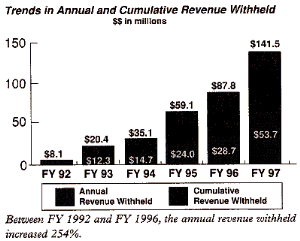
Since FY 1992, Congress has continued to withhold increasing amounts of PTO customer fees. Initially, the amounts withheld were small compared with PTO revenues in total. They ranged from $8.1 million in FY 1992 to $28.7 million in FY 1996. PTO was able to absorb these revenue restrictions in its operating budget with controlled adverse effects on programs. Indeed, the annual amount of fees withheld has risen more than 254 percent since FY 1992, and the cumulative total of fees collected by, but unavailable to, the PTO as of the end of FY 1996 was $87.8 million. In FY 1997, the customer fees withheld will almost double, rising from $28.7 million to $53.7 million.
This revenue restriction of $53.7 million can be absorbed only in the operating budget of the PTO. For FY 1997, the cumulative amount of fees withheld will reach $141.5 million according to current appropriations and apportionment schedules. By law, these restrictions are scheduled to continue through FY 1998 and will be available to the PTO only through the appropriations process.
If, in FY 1998, the PTO were to experience an even larger withholding of its fee revenue, it would reduce the PTOs ability to pay for any service except basic compensation of employees and necessary support services. Future upgrades or investments in information technology would be inhibited.
With a reduction in overtime for examination and the reduction in examiner hiring, patent pendency would continue to rise. Those familiar with the patent process understand that the full cost of examining a patent is not recovered through the payment of the initial fee. The cost of examining and issuing a patent is paid for in an elongated revenue stream that begins with the application fee and continues through the issue date, in the form of the issue fee, and well past the date of issue in the form of maintenance fees. Less profitable patents are allowed to expire by their owners; more successful and profitable patents are kept in force through the payment of maintenance fees at three years, seven years, and 11 years after issue. These maintenance fees paid on profitable patents are used to cover the costs of newly received patent applications, as the application fee alone does not recover the full cost of examination.
However, both issue fees and maintenance fees are time sensitive (i.e., they are both dependent upon pendency or the time it takes to examine and prepare a patent for issue). For example, if the pendency time were to increase from 18 months to 20 months to 22 months, the revenue stream for the PTO would become elongated. Immediately, less issue fee revenue would be available to support the patent process. Eventually, the impact would be felt on maintenance fee income and this would continue to have an effect for up to 11 years. There would be no quick fix for this lengthened revenue stream.
Allocation of Cash and Fund Balances
User fees are the source of all revenues earned by the PTO. Patent and trademark rights, grants, registrations, and related products and services are sold to the public for fees assessed. As the demand for PTO products and services has increased, fee collections have continued to climb, with a concurrent increase in the amount of work waiting to be processed and in process. In turn, this increase in workload has given rise to an increase in deferred revenues that has resulted in large year-end balances in the Fund Balance with Treasury and Cash accounts. Although the balances in these accounts may appear substantial, it must be remembered that the PTO, while operating as a fully customer fee-funded operation, is still an entity of the U.S. Government, subject to Federal appropriations law, and is not authorized to invest its cash and fund balances.
While the PTO prepares and publishes financial statements in accordance with the CFO Act requirements, it still operates on the cash basis required by appropriations law. The PTO has no investment authority, no borrowing authority, and no lines of credit. In order for the PTO to spend $1.00, it must have collected or anticipate the collection of that dollar in the same fiscal year. For the PTO to enter into a contract for $5 million worth of services, it must have collected or anticipate the collection of $5 million in fees during the fiscal year. By the end of the fiscal year, there must be collected fees in the Fund Balance with Treasury and Cash accounts to cover all outstanding obligations. However, under the generally accepted accounting and reporting requirements, these obligations, or outstanding contracts, do not appear on the financial statements. These are only referenced in the footnotes to the statements.
Unobligated balances of total funds available to the PTO amounted to only $27.0 million at the end of FY 1996. This is only a small percentage of the Fund Balance account with the U.S. Treasury. The nature of the CFO financial statements, if interpreted as a cash-basis, appropriated government entity, can lead to the conclusion that the PTOs fund balances are funds available for obligation, rather than funds that have already been obligated and will be required to liquidate outstanding contractual liabilities. No private enterprise would keep such large fund balances on hand; rather, fund balances would be invested. However, the PTO is not a private enterprise; it is a government entity that has no choice but to present large fund balances on its financial statements.
The chart below demonstrates the differences between accounting for fund balances on an appropriations accounting basis used in the budgeting process and a financial accounting basis as reported under the requirements of the CFO Act. The appropriations accounting basis shows that once all fund balances are allocated to cover Obligations and net Accounts Payable and Accounts Receivable, Cash In Transit, Deposit Accounts, and Revenue Withheld, only $27 million in unobligated funds remains. Of this amount , $26.1 million is in unobligated advance fees in excess of the amount that the PTO had authority to use, and $0.9 million is reserved pending resolution of a restricted funds rescission. The Cash in Transit of $64.9 million represents undeposited checks as of September 30, 1996. The Deposit Accounts of $41.5 million are monies paid to the PTO for future services. Revenue Withheld of $87.8 million is the cumulative revenue withheld since 1992, which is unavailable for the PTOs use until appropriated by Congress. Last, Obligations and net Accounts Payable and Accounts Receivable represent the total of undelivered orders, net of Accounts Payable and Accounts Receivable as of September 30, 1996.
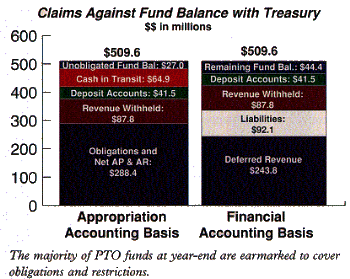
From a financial accounting basis, the Remaining Fund Balance of $44.4 million represents the cumulative margin since establishment of the PTO. The Deposit Accounts of $41.5 million are monies paid to the PTO for future services. Revenue Withheld of $87.8 million is the cumulative revenue withheld since 1992, which is unavailable for the PTOs use until appropriated by Congress. Liabilities consist of $48.3 million in Accounts Payable, Accrued Payroll and Benefits of $22.9 million, the Other Liability Due to Treasury of $0.9 million, and the Actuarial and Leave Liabilities of $20 million, representing annual leave owed to PTO employees and the PTOs portion of the Federal Employee Compensation Act for its employees. e Finally, Deferred Revenue of $243.8 million represents undeposited checks at year end and fees received for services, but not fully earned as of September 30, 1996.
Allocation of Net Position
In the aggregate, the various components of the Net Position section on the Statement of Financial Position are also referred to as equity. Equity is the residual interest in the assets of the entity that remains after or deducting its liabilities. Components of the PTOs Net Position for the most recent three years are shown above. The Total Net Position increase of $34.0 million from FY 1995 to FY 1996 includes $28.7 million that is not available for the PTOs use because it has not been granted the budget authority to access it.
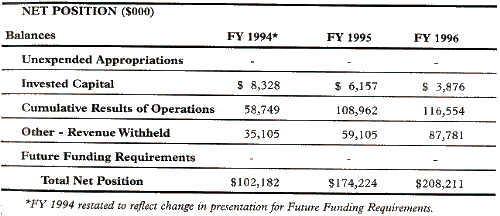
For FY 1994 through FY 1996, the PTO had no Unexpended Appropriations or Future Funding Requirements. However, before FY 1995, the PTO reported a Future Funding Requirement for the noncurrent portion of the liability for employee leave and capital leases. This presentation was changed in FY 1995, and the FY 1994 financial statements were restated. Thus, for financial statement reporting purposes, the PTO reports the noncurrent portion of the employee leave liability as a liability covered by budgetary resources, as long as there are sufficient resources available. Also, because PTO is no longer funded from an annual appropriation, the balance in the Invested Capital (an appropriated fund account) will decrease each year by the amount of depreciation associated with the respective capital accounts, eventually zeroing out.
The Cumulative Results of Operations (CRO) represents the cumulative unrestricted net operating gain recognized by the entity since its inception. The CRO increases or decreases each year by the amount on the line of the Statement of Operations and Changes in Net Position titled Excess of Revenues and Financing Sources Over Total Expenses. This line represents the difference between (1) revenues and financing sources and (2) expenses. However, in practice, not all of that line is allocated to the CRO. Instead, a portion of the amount is diverted each year into a restricted revenue withheld account at Treasury. These fee collections are used by Congress to offset increased spending in other Federal programs, which reduces the PTOs budget authority and restricts its ability to spend all e of its customers fees to accomplish patent work.
As of the end of FY 1996, the PTOs CRO was $116.5 million. Thus, of the total assets presented on the PTOs Statement of Financial Position, the governments interest consists of net property and equipment (P&E), as there are no outstanding liens against any of these assets. P&E appears on the balance sheet in the amount of $71.4 million; however, $3.9 million of the P&E was purchased with appropriated funds and appears on the Invested Capital line, leaving $67.5 million in P&E in which the PTOs CRO has an interest. The Accounts Receivable of $4.6 million also represents a portion of the PTOs CRO. The remaining balance of $44.4 million is the PTOs interest in the Fund Balance account.
Trends in Revenues and Expenses
Fee collections have continued to climb as the demand for PTO products and services has increased. Customers pay fees when they order the products and services. The increase in collections caused the PTO to record large year-end balances in the Statement of Financial Position accounts titled Fund Balance with Treasury and Cumulative Results of Operations. The three-year trends in revenues, expenses, and margin are shown below.
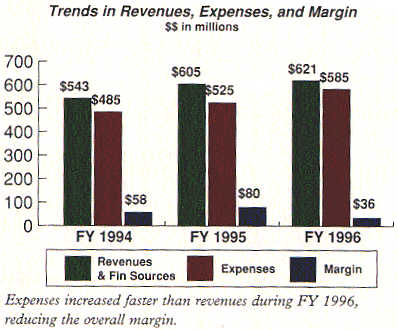
Most revenue represents income from the sales of goods and services; however, $2.3 million was from another financing source, appropriated capital, used during the year. or Total income from fee collections (patents and trademarks) in FY 1996 was $618.9 million; an increase of 2.6 percent from FY 1995 fee income of $603 million. Maintenance fees accounted for $211.8 million of the FY 1996 collections. Patent maintenance fees are collected by the PTO from owners of previously issued patents over the life of the patent. If maintenance fees are not remitted at each of three stages, patents will expire. Anticipated renewal rates are planned based on the most recent historical data, which are currently: 79 percent at the first stage (at the end of the third year after a patent is issued); 55 percent at the second stage (at the end of the seventh year after a patent is issued); and 32 percent at the third stage (at the end of the 11th year after a patent is issued). Although revenues from Patent and Trademark applications rose $16 million, the margin decreased between FY 1995 and FY 1996 by $44 million due primarily to four reasons: (1) expenses for personnel services rose $21.2 million; (2) expenses for contractual services increased by $27.2 million; (3) depreciation expense climbed $8.1 million reflecting increased capital investments; and (4) the calculation for deferred revenue was refined.
The PTO received 191,116 utility, plant and reissue (UPR) patent applications and 15,160 design applications. The UPR application filings workload decreased by 13.6 percent below the previous year and the design applications decreased slightly by 1.4 percent. This decrease in UPR filings is an anomaly, resulting from a change in the law during the previous year, which created a surge in patent application filings in FY 1995 prior to the legislation becoming effective. Despite recent decreases, the forecast is for increased UPR and design applications.
In FY 1996, the PTO received 200,640 trademark applications, an increase of 14.5 percent from last years filing level of 175,307. The number of applications has continued to increase at higher than anticipated rates, increasing 60 percent over the past five years while staffing levels for the same period increased less than 10 percent.
Total Expenses for FY 1996 amounted to $584.9 million, of which Operating Expenses accounted for $553.7 million. This is a 10.2 percent increase in Operating Expenses from FY 1995, primarily the result of an increase in contractual services. As a provider of products and services, the PTOs personnel costs represent its greatest expense. In FY 1996, salaries and benefits were $330.8 million, accounting for 59.7 percent of total operating expenses, rising from $309.6 million in FY 1995, although decreasing slightly as a percent of total operating expenses from 61.6 percent. The decrease reflects the effect of Federal hiring constraints, as workloads rise disproportionately higher than increases in the number of employees.
Investments in new automation technology have increased as some processes transform from paper-based to electronic systems. This increase will be significantly reduced in the future because of restrictions placed on the PTOs ability to spend the fees it collects. One of the PTOs largest automation efforts is the deployment of the Automated Patent System (APS). While a portion of the costs associated with deploying the APS is expensed as incurred, other costs are capitalized and depreciated over the useful life of the system. Thus, the Statement of Operations includes both APS costs expensed in FY 1996 and the annual depreciation recognized.
To provide market incentives for those seeking patents, the current patent fee structure allows for lower initial fees that are supplemented by income from other sources, such as maintenance fees, to cover the full cost of the patent examination and issuance process as well as other PTO operations (e.g., patent documentation and quality review). As with the decision to apply for a patent, the decision to renew a patent rests entirely with the patent owner and is subject to industry and market considerations. However, since the maintenance fees are the largest category of fee income, fluctuations in rates of renewal can significantly affect revenues. PTO analysts compare fee plans to actual revenue received, project income using regression analyses and other economic models, and adjust projections accordingly.
The result is that, in FY 1996, the PTO experienced growth in its revenues and expenses, with a decrease in the operating margin from FY 1995. However, growth in revenues was limited due to an increase in deferred revenues. The examination processes rely heavily upon trained and experienced patent examiners and trademark attorneys. With recruiting efforts being further curtailed by the FY 1997 budget cuts, backlogs of PTO applications will increase.
Changes in Principal Accounts
Most of the assets managed by the PTO are funds deposited at Treasury, cash, and capital equipment. To expedite the collection and deposit of funds, customers are offered various mechanisms for remitting fees. These include payment by mail, payment by electronic transfer, payment to cashiers located in the PTO office complex, and establishment and use of deposit accounts. Capital equipment includes hardware, software, and office furniture and equipment.
Liabilities are divided between Intra-governmental Liabilities and Governmental Liabilities. Most PTO liabilities result from deferred revenues, i.e., undeposited checks at year-end and fees received for services requested, but not fully earned until the services are completed. Other significant PTO liabilities include the deposit accounts and accounts payable.
The PTO reports its equity in three components: invested capital, cumulative results of operations, and other -- revenue withheld. A detailed discussion of each component was provided earlier.
Comparisons of the ending balances of selected asset, liability, and equity accounts for FY 1994 through FY 1996, as reflected in the respective years Statement of Financial Position, are shown in the charts that follow. The graphs presented do not display ending balances by line item, and all amounts are rounded to the nearest million dollars. Amounts contained in the narrative are rounded to the nearest tenth of a million dollars and percentages are rounded to the nearest tenth of a percent. All numbers are derived from amounts appearing in the financial statements. Also, it is important to note that the restricted fund balances and equity segments associated with patent revenue withheld are not available for use without additional appropriations by Congress.
SELECTED ASSET ACCOUNTS ANALYSES portrayed are to assist the reader in understanding the nature of the assets included in the balance sheet, the current three-year trends, and the extent of the future economic benefit to the PTO. The accounts presented below include Fund Balance with Treasury and Property and Equipment.
Fund Balance with Treasury includes the amounts set aside for the payment of outstanding obligations and restricted funds for the deposit accounts, nonentity funds, and revenue withheld by Congress. Of the $444.7 million total balance for FY 1996, the unobligated funds available totaled only $26.1 million, a decrease of 62.5 percent below the FY 1995 unobligated amount of $69.6 million. The unobligated fund balance of $26.1 million is in excess of the amount which the PTO had the authority to use. Of the $130.1 million in restricted funds, $0.9 million is reserved pending resolution of a restricted funds rescission.
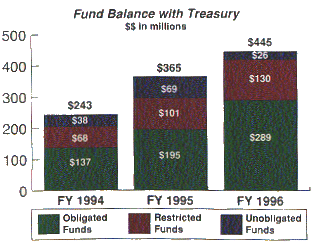
Property and Equipment (P&E) is stated at net book value of $71.4 million, which is the original acquisition cost of $161.5 million less the total accumulated depreciation of $90.1 million. Reducing the carrying value of P&E balances by depreciation values provides for the economic distribution of the cost of using these assets over time. The P&E increase of 34.2 percent from the FY 1995 balance of $53.2 million is the result of purchases of APS equipment and software, other Automated Data Processing (ADP) equipment and software, a network/telecommunications upgrade, and office furniture. Since FY 1994, net P&E has grown 38.8 percent.
SELECTED LIABILITY ACCOUNTS ANALYSES are discussed to assist the reader in understanding the nature of liabilities included in the Statement of Financial Position. The graphs portray three-year trends in selected liability accounts. The PTO classifies the accrued annual leave as a Liability Covered by Budgetary Resources instead of a Liability Not Covered by Budgetary Resources, as there are sufficient resources available at year-end. However, these amounts remain unobligated for budgetary purposes at the close of FY 1996. Accounts presented include Accounts Payable, Deposit Accounts, and Deferred Revenue.
Accounts Payable balances shown include Federal and non-Federal accounts payable. These are monies owed for goods and services received for which the PTO has not yet made payment. At the end of FY 1996, payments owed other Federal agencies (intragovernmental) totaled $5.3 million, a 5.5 percent decrease from $5.6 million in FY 1995. In addition $43.0 million was owed to non-Federal entities (governmental), a 30.3 percent increase from $33.0 million in FY 1995 resulting primarily from the effects of the Continuing Resolution. The total balance has realized a net increase of 66.6 percent since FY 1994.
Deposit Accounts are maintained by the PTO as a service to its customers. The associated liability results from monies paid to the PTO in anticipation of a future demand for services. Upon receipt of a service request from a customer maintaining a deposit account, the PTO deducts the appropriate fee from the respective account. At the end of FY 1996, the liability was $41.5 million, an increase of 15.8 percent over the FY 1995 balance of $35.8 million. This reflects a decrease in charges against customer deposit accounts resulting from a rise in unprocessed applications, as well as a small increase in the number of accounts. The balance has increased 27.9 percent since 1994.
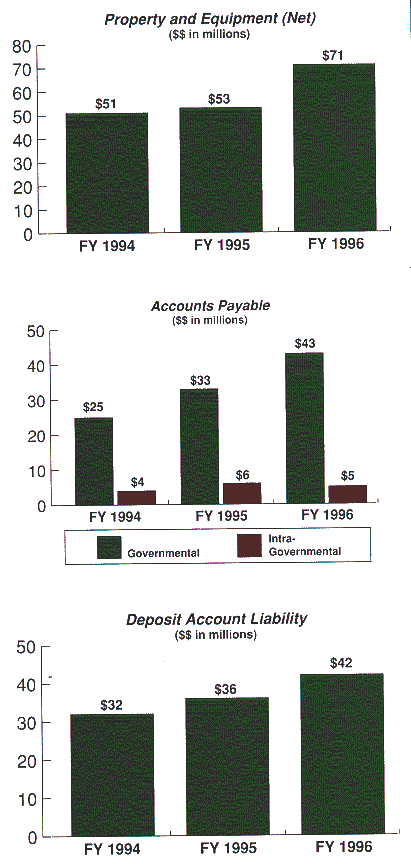
Deferred Revenue represents undeposited checks at year-end and fees received for services requested, but not fully earned until the services are completed. This differs from advances to deposit accounts for which a specific service has not yet been requested; however, funds to cover future requests are held by the PTO. Deferred revenue at September 30, 1996, was $243.8 million, an increase of 40.6 percent from the FY 1995 balance of $173.4 million. The increase resulted, in part, from a one-month increase in the pendency cycle and an increased backlog of undeposited checks at year-end. A business process re-engineering effort is currently under way to help abate the rising backlog. In addition, the deferred revenue calculation was refined, resulting in additional deferrals. The balance has risen 88.8 percent since FY 1994.
EQUITY ACCOUNTS ANALYSES are presented for comparative fiscal years. Equity is the residual interest in the assets of the entity that remains after deducting its liabilities. From FY 1995 to FY 1996, the equity or net position increased $34.million. However, $28.7 million of this resulted from an increase in revenue withheld. The PTO reports its equity in three components: invested capital, cumulative results of operations, and other -- revenue withheld. In the aggregate, these components of equity comprise the PTOs net position and each component is discussed below.
Invested Capital is the net book value of capitalized fixed assets that were purchased with appropriations from general taxpayer revenue. Because the PTO is no longer funded from taxpayer revenues, this account balance will decrease each year as depreciation expense is realized. The balance in this account was $3.9 million on September 30, 1996, a decrease of 37.0 percent from the balance of $6.2 million on September 30, 1995. Since 1994, the balance has decreased 53.5 percent.
Cumulative Results of Operations represents the cumulative unrestricted net operating results recognized by the entity since its inception. The balance in this account does not include the revenue withheld that has been earned, but not appropriated for use. The equity account for revenue withheld is shown separately. The balance in the CRO account was $116.5 million on September 30, 1996, an increase of 7.0 percent from the balance of $109.0 million a year earlier. Since 1994, the balance has grown 98.4 percent from $58.7 million. This growth results, in part, from increased capital investments.
Other -- Revenue Withheld is the third component of PTO net position. This portion of the equity is segregated because of restrictions associated with the unavailability of the customer-paid fees. Although these fees were earned, additional action by Congress is required to make these balances available for use by the PTO. Total revenue withheld reached $87.8 million at the end of FY 1996, an increase of 48.5 percent over the FY 1995 balance of $59.1 million. Since 1994, the revenue with held has increased 150.1 percent.
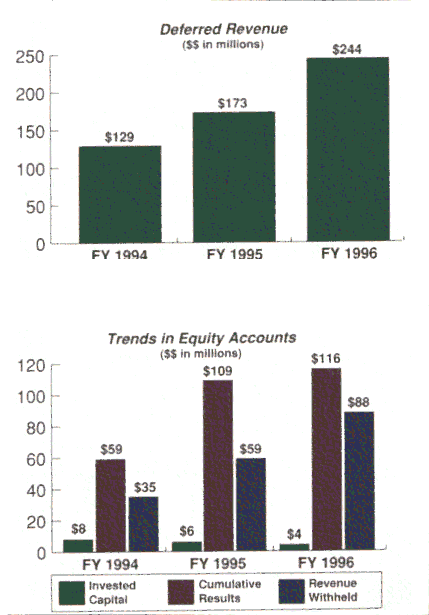
Significant Actions, Accomplishments, and Results
Financial Management: Quantitative indicators, as prescribed by the Office of Management and Budget (OMB), monitor progress toward improved financial management. The preceding chart depicts the goals or target performance established by OMB for FY 1996 and the performance of the PTO during that period.
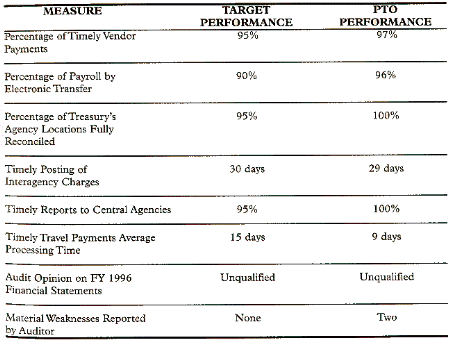
Financial Systems: At the beginning of FY 1992, the PTO implemented the Federal Financial System (FFS) and assumed responsibility for all accounting records. Software and hardware support for the core system are supplied via a cross-servicing arrangement with the U.S. Geological Survey of the Department of the Interior. Improvements for FY 1996 and enhancements planned for FY 1997 to PTOs financial management system include:
- interim upgrade to the procurement subsystem that was implemented in FY 1996;
- subsequent major upgrade to the procurement subsystem scheduled for mid-1997;
- improvements to the travel subsystem;
- redevelopment of the revenue accounting system, planned for implementation in May 1997;
- continuing implementation of the re-engineered budget process;
- implementation of an interface between the capitalizable property subsystem and the core financial system, which began in January 1996;
- continuing implementation of a pilot Electronic Data Interchange to enhance Electronic Commerce capabilities and improvement initiatives;
- deployment of a data warehousing pilot on September 30, 1996, and continuing efforts for an enterprise-wide data warehouse;
- enhancements to the Budget Formulation Module for preparing budget estimates; and
- enhancements to the Budget Allocation Module for preparing operating plans after budget enactment.
Management Controls: For FY 1996, the PTO provided reasonable assurance of compliance with the provisions of the Federal Managers Financial Integrity Act. Weaknesses in existing subsystems were identified in past years and reported to the Department of Commerce. Additional weaknesses were identified by the Office of Inspector General during its audit of the FY 1995 financial statements. Reported weaknesses and anticipated dates for full correction follow.
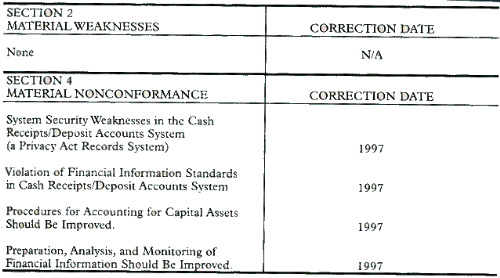
Limitations of Financial Statements
Pursuant to the requirements of the Chief Financial Officers Act of 1990, as amended by the Government Management Reform Act of 1994, the financial statements that follow have been prepared to report the financial position and results of operations of the Patent and Trademark Office. The fiscal year 1996 financial statements consist of the Statement of Financial Position, the Statement of Operations and Changes in Net Position, and the Statement of Cash Flows. The following limitations apply to the preparation of the fiscal year 1996 financial statements:
- While the statements are prepared from the books and records of the entity in accordance with the formats prescribed by the Office of Management and Budget (OMB), the statements are different from the financial reports used to monitor and control budgetary resources that are prepared from the same books and records.
- The statements should be read with the realization that they are for a component of a sovereign entity, that liabilities not covered by budgetary resources cannot be liquidated without the enactment of an appropriation, and that the payment of all liabilities other than for contracts can be abrogated by the sovereign entity.
Statement of Financial Position
Statement of Operations and Changes in Net Position
Statement of Cash Flows (Indirect)
Notes to the Financial Statements
NOTE 1. Summary of Significant Accounting Policies
Basis of Presentation
As required by the Chief Financial Officers Act of 1990, these financial statements report the financial position and results of operations of the Patent and Trademark Office (PTO) of the United States. The books and records of the PTO serve as the source of the information contained herein. The financial statements were prepared in accordance with the guidance specified by the Office of Management and Budget (OMB) in Bulletin 94-01, as well as the accounting policies of the PTO; therefore, they may differ from other financial reports submitted pursuant to OMB directives for the purpose of monitoring and controlling the use of the PTOs budgetary resources.
Reporting Entity
The Patent and Trademark Office is a program of the U.S. Department of Commerce (DOC) that administers the Nations patent and trademark laws. Since the passage of the Omnibus Budget Reconciliation Act of 1990 (OBRA), the program has been funded almost entirely by user fees. Prior to FY 1993, the appropriated funds from general taxpayer revenue gradually decreased until PTO became fully fee funded in FY 1993. The bulk of the fees collected are offsetting collections that are retained by the PTO until expended; however, the revenue withheld imposed on statutory patent fees with the enactment of the OBRA constitutes an offsetting receipt. These offsetting receipts are deposited into a restricted account at the U.S. Treasury. The PTO is only authorized to use monies from this account to the extent appropriated by Congress. Thus, the U.S. Treasury makes these funds available to the PTO by the issuance of a warrant each month to the extent such funds were authorized for use. The excess monies are not available to the PTO and are retained in a restricted receipt account by the U.S. Treasury. Any authorized funding that is not expended during a given fiscal year is carried forward for use in the following fiscal year.
The accompanying financial statements include the accounts for salaries and expense (13X1006), surcharge (revenue withheld) (13X5127), and customer deposits (13X6542) appropriations, which are under the control of the PTO. The PTO has no lending or borrowing authority.
Budgets and Budgetary Accounting
In FY 1993 through 1996, the majority of funding was received through the collection of user fees. User fee rates are established by rule and law.
Revenue withheld on patent statutory fees was established by the OBRA. Subsequent pieces of legislation removed the reference to a specific surcharge withholding of 69 percent, required the PTO to deposit exact amounts of revenue withheld, and extended the revenue withheld through the end of FY 1998. These represent offsetting receipts and are available to the PTO only to the extent appropriated by Congress. All revenue withheld is recorded as revenue. However, any revenue withheld by the PTO, but not appropriated by Congress for use, is maintained by the U.S. Treasury as restricted funds.
Fees other than the revenue withholding fees referenced above are offsetting collections and are available to the PTO until expended. Funds authorized but not used in a given fiscal year are carried forward for use in future periods.
Basis of Accounting
Transactions are recorded on the accrual basis of accounting as well as on a budgetary basis. Under the accrual method, revenues are recognized when earned, and expenses are recognized when a liability is incurred, without regard to the receipt or payment of cash. Budgetary accounting facilitates compliance with legal constraints and controls over the use of Federal funds. The accompanying financial statements are presented on the accrual basis of accounting.
Revenues and Other Financing Sources
In FY 1993 through 1996, the majority of revenues were derived from the collection of user fees. Appropriations expended in prior years for the purchase of property and equipment are recognized as revenues, as the assets are consumed in operations.
Advance payments made by customers for services not yet requested are recorded as liabilities in customer deposit accounts until services are rendered. Fees that are remitted with initial applications and other services are recorded as revenue when received. A manual calculation is made at year-end to estimate deferred revenue for services that have not been performed. The methodology for calculating deferred revenue was expanded to include new sources of deferred revenue, most significantly, issue fees.
Although not material in amount, some financial gifts and gifts-in-kind are received from anonymous donors. Most gifts-in-kind are used for official travel to further the attainment of the mission and management objectives of the PTO. The results of these transactions are not reflected in the PTO statements, but are included in the consolidated Gifts and Bequests Fund statements prepared by the Department of Commerce.
Funds with the U.S. Treasury
Commercial bank accounts are maintained to deposit revenues collected. All monies maintained in such accounts are transferred to the Federal Reserve Bank on the next business day following the day of deposit. In addition, some customer deposits are wired directly to the Federal Reserve Bank. All banking activity is conducted in accordance with the directives issued by the Financial Management Service of the U.S. Treasury Department. With the exception of those that are restricted, funds with the U.S. Treasury and cash are available to pay current liabilities and to finance duly authorized purchases. All disbursements are processed by the Philadelphia Regional Finance Center of the U.S. Treasury Department.
Accounts Receivable
Governmental accounts receivable represent amounts due from non-Federal entities, the majority of which are due from former employees for the reimbursement of education expenses. Intragovernmental accounts receivable represent amounts due from other Federal entities, of which $3.9 million is due to a financing agreement entered into in FY 1995 with the Department of Commerce to fund the Commerce Administrative Management System.
Advances and Prepayments
Advances and prepayments have decreased significantly in the current fiscal year for two reasons. First, management elected not to prepay 1997 servicing of the Federal Financial System (FFS) by the U.S. Geological Survey (USGS) after exhausting the existing prepaid balance. Second, American Express card usage has been rising, particularly among frequent travelers, reducing the need for travel advances.
Cash
The majority of the cash balance consists of checks not yet deposited at the U.S. Treasury Department that are a result of fees collected by the PTO that have not been processed due to the lag time between receipt and initial review. Small cash balances are also held outside the U.S. Treasury Department that are not material and are used as imprest funds to facilitate small purchases, local travel, and emergency salary advances. The cash balance includes undeposited checks of $64,857,387 and $41,579,809 in FY 1996 and 1995, respectively, and an imprest fund of $15,000 in both years.
Property and Equipment
The buildings in which the PTO operates are leased from private concerns by the General Services Administration (GSA). Long-term leases are negotiated by GSA and appropriate rent charges are levied. The rental rates assessed by GSA and paid by the PTO approximate the market rates for similar commercial properties.
Automated data processing software purchased off the shelf with an estimated service life of two years or greater is capitalized when the cost exceeds $25,000.
The costs for developing custom software are capitalized when incurred for creating the detailed design, coding, and final testing of the software.
Bulk purchase costs of furniture, with an estimated service life of two years or greater are capitalized when the total monetary value of the purchase order/delivery order equals or exceeds $50,000 (including shipping and installation).
Automated Patent System (APS) equipment and other assets with an individual unit cost of $5,000 or greater (including shipping and installation) and an estimated service life of two years or greater are capitalized. In instances other than those listed above, the entire cost is recorded as an expense upon receipt of the equipment or other asset with the following exceptions:
(1) The total amount of the order, including shipping and installation, is capitalized if the equipment procured is made via a major contract.
(2) The total amount of the order, including shipping and installation, is capitalized if the procurement represents the initial purchase of equipment in connection with the installation of a major system.
(3) If the procurement represents the purchase of additional items for an existing major system, only those items with an individual unit cost of $5,000 or greater will be capitalized.
Depreciation is calculated using the straight line method over the following service lives: APS equipment 3-10 years, APS software 3-11 years, ADP equipment 3-5 years, ADP software 3 years, PTOnet equipment 3-5 years, equipment 3-5 years, and furniture 5 years.
Liabilities
Liabilities represent the amount of monies or other resources that are likely to be paid by the PTO as the direct result of an event that has already occurred. All such liabilities recognized in FY 1993 through 1996 have been fully funded. However, no liability can be paid by the PTO unless funding is available. Also, liabilities of the PTO arising from other than contracts can be abrogated by the government acting in its sovereign capacity.
Annual, Sick, and Other Leave
Annual leave is accrued as it is earned, and the accrual is reduced as leave is taken. An adjustment is made at the end of each fiscal year to ensure that the balance in the accrued annual leave account reflects current pay rates. Accrued annual leave is reported as covered by budgetary resources for financial statement presentation only. No portion of this liability has been obligated. To the extent current or prior year funding is not available to cover annual leave earned but not taken, funding will be obtained from future financing sources.
Sick leave and other types of non-vested leave are expensed as taken. Any liability for sick leave that is accrued by an individual but not taken is transferred to the Office of Personnel Management upon the retirement of that individual.
Retirement Plan
The PTO employees participate in the Civil Service Retirement System (CSRS) or the Federal Employees Retirement System (FERS). The FERS was established by the enactment of Public Law 99-335. Pursuant to this law, most employees hired after December 31, 1983, are automatically covered by FERS and Social Security. Employees hired prior to January 1, 1984, can elect to join either FERS and Social Security or remain in CSRS.
For those employees covered by the CSRS, the PTO makes contributions equivalent to seven percent of the employees pay. For those covered by the FERS, the PTO makes contributions equal to approximately 13 percent.
All employees are eligible to contribute to a thrift savings plan. For those employees participating in the FERS, a thrift savings plan is automatically established, and the PTO makes a mandatory one percent contribution to this plan. In addition, PTO makes matching contributions, ranging from one to four percent, for FERS eligible employees who contribute to their thrift savings plans. No matching contributions are made to the thrift savings plans established by CSRS employees.
FERS employees and certain CSRS reinstatement employees are eligible to participate in the Social Security program after retirement. In these instances, the PTO remits the employers share of the required contribution.
The financial statements of the PTO do not report CSRS or FERS assets, accumulated plan benefits, or unfunded liabilities, if any, which may be applicable to its employees. Such reporting is the responsibility of the Office of Personnel Management.
Additionally, as required by the Federal Workforce Restructuring Act of 1994, the PTO contributed $80 per position on the roles as of March 31, 1996, to the Civil Service Retirement and Disability Fund.
Comparative Data
1995 Financial Statements were reclassified and restated to conform with the 1996 presentation.
NOTE 2. Fund Balance with Treasury
Fund Balance with Treasury consisted of the following as of September 30:
Available Restricted 1996 1995
Appropriated Funds - Obligated$288,488,847$ 0$288,488,847$194,891,312
Appropriated Funds - Unobligated26,056,319026,056,31969,552,870
Deposit Accounts041,479,55441,479,55435,809,058
Revenue Withheld087,780,99987,780,99959,104,999
Non-Entity Funds (note 8)0871,000871,0005,920,000
Total Fund Balances$314,545,166$130,131,553$444,676,719$365,278,239
Deposit Account balances represent advance payments by customers for future services.
Revenue Withheld represents fees earned, but not available for use.
NOTE 3. Property and Equipment
Property and Equipment consisted of the following as of September 30, 1996:
-------------------------------------------------------------------------------- Service Acquisition Accumulated Net Book Life Value Depreciation Value (Years) -------------------------------------------------------------------------------- Classes of Fixed Assets APS Equipment 3-10 $46,115,075 $37,637,452 $8,477,623 APS Software 3-11 23,716,925 16,658,225 $7,058,700 APS Software in Progress * 1,886,537 0 $1,886,537 ADP Equipment 3-5 42,319,787 19,917,368 $22,402,419 ADP Software 3 14,668,421 3,879,608 $10,788,813 PTOnet 3-5 17,586,461 5,027,795 $12,558,666 Equipment 3-5 7,443,614 4,175,867 $3,267,747 Furniture 5 7,786,168 2,817,853 $4,968,315 -------------------------------------------------------------------------------- Total $161,522,988 $90,114,168 $71,408,820 --------------------------------------------------------------------------------
*Note that software in progress is not depreciated as it has not yet been placed in service.
Property and Equipment consisted of the following as of September 30, 1995:
------------------------------------------------------------------------------------- Service Acquisition Accumulated Net Book Life Value Depreciation Value (Years) ------------------------------------------------------------------------------------- Classes of Fixed Assets APS Equipment 3-10 $45,667,899 $32,284,610 $13,383,289 APS Software 3-11 22,754,455 12,460,550 10,293,905 ADP Equipment 3-5 30,301,044 14,612,765 15,688,279 ADP Software 3 6,825,181 2,135,841 4,689,340 PTOnet 3-5 3,542,741 1,680,892 1,861,849 Equipment 3-5 4,051,106 1,634,624 2,416,482 Assets Under Capital Lease 3-5 1,693,138 807,897 885,241 Furniture 5 6,179,017 2,191,062 3,987,955 ------------------------------------------------------------------------------------- Total $121,014,581 $67,808,241 $53,206,340 -------------------------------------------------------------------------------------
Assets Under Capital Lease are for reproduction equipment.
NOTE 4. Actuarial Liabilities
The Federal Employees Compensation Act (FECA) provides income and medical cost protection to covered Federal civilian employees injured on the job, employees who have incurred a work-related occupational disease, and beneficiaries of employees whose death is attributable to a job-related injury or occupational disease. Claims incurred for benefits for Patent and Trademark Office (PTO) employees under FECA are administered by the Department of Labor (DOL) and are ultimately paid by the PTO. These future workers compensation estimates were generated from an application of actuarial procedures developed to estimate the liability for FECA benefits. The actuarial liability estimates for FECA benefits include the expected liability for death, disability, medical, and miscellaneous costs for approved compensation cases. The liability was determined using the paid losses extrapolation method calculated over the next 23-year period. This method utilizes historical benefit payment patterns related to a specific incurred period to predict the ultimate payments related to that period. These annual benefit payments have been discounted to present value. Interest rate assumptions utilized for discounting were as follows:
1996 1995 6.21% in year 1, 7.10% in year 1, 5.97% in year 2, 6.60% in year 2, 5.60% in year 3, and 7.00% thereafter. 5.32% in year 4, 5.15% in year 5, and 5.10% thereafter.Based on information provided by the Department of Labor, the Department of Commerce determined that the estimated liability of the PTO as of September 30, 1996 and 1995, was $3,085,691 and $2,486,292, respectively.
NOTE 5. Deferred Revenue
Deferred revenue represents fees that have been received for requested services, but will not be earned until the related service is provided. Two types of deferred revenues are recorded. The first type results from checks received with a request for a service that were not deposited because of a backlog in production. The second type of deferred revenue relates primarily to fees for applications that have been partially processed and issue fees collected for which the patent has not been issued.
Application fees received that have undergone the initial processing phase but have not been reviewed by a patent examiner or a trademark attorney are deferred and revenues are recognized to the extent costs are incurred in the initial processing phase. The balance of the application fees received is considered unearned. Issue fees are earned over a 10-week processing cycle. Expenses for issues are evenly distributed over the processing cycle and revenue is earned to the extent processing is completed, with the remaining issues-in-process considered unearned.
Deferred revenue consisted of the following as of September 30:
1996 1995 Checks received but not deposited $ 64,857,387 $ 41,204,361 Unearned fees 178,918,841 132,184,545 ----------------------------------------------------- Total Deferred Revenue $243,776,228 $173,388,906NOTE 6. Leases
Capital Leases:
During FY 1996, PTO entered into agreements to purchase all reproduction equipment under capital lease. At year-end the remaining lease liability balance, consisting of the prior year balance plus FY1996 additions, net of fiscal year principal payments and cancellations, totaled approximately $587,000. This balance was transferred to Accounts Payable, reducing the lease liability to zero. In addition, the equipment and its associated accumulated depreciation were reclassified from assets under capital lease to office equipment.
Operating Leases:
The buildings in which PTO operates are leased by the General Services Administration (GSA), and PTO is charged rent intended to approximate commercial rental rates. The majority of PTOs lease agreements will expire in early FY 1997. The PTO and GSA are currently involved in negotiations for future space requirements. Future lease payments are as follows:
Fiscal Year
1997 $ 55,105,000
1998 (estimate) 56,483,000
1999 (estimate) 59,100,997
2000 (estimate) 61,819,578
2001 (estimate) 64,544,412
Total Future Lease Payments $297,052,987
Rent expense was $41,304,825 and $38,255,285 in FY 1996 and 1995, respectively.
NOTE 7. Program/Operating Expenses
For the Years Ended September 30:
1996 1995 Operating Expenses by Object Classification Personal Services and Benefits $330,792,464 $309,640,671 Travel and Transportation 1,826,475 1,286,538 Rental, Communication and Utilities 52,190,259 48,674,938 Printing and Reproduction 30,885,071 31,465,962 Contractual Services 93,249,565 66,025,572 Supplies and Materials 8,698,543 8,128,731 Equipment not Capitalized 7,357,432 5,711,426 Insurance Claims and Indemnities 31,050 42,800 Other: (a) Other services 3,160,913 8,625,483 (b) Training 6,344,608 6,163,940 (c) Maintenance and Repair 19,139,311 16,539,331 ------------------------------------------------------------------------------ Total Expenses by Object Class $553,675,691 $502,305,392 ------------------------------------------------------------------------------Personal Services and Benefits remained at approximately the same percent of the total budget. Contractual services increased as contract labor was needed to offset the hiring restrictions (FTE limitations).
NOTE 8. Permanent Cancellation/Rescission of Funds
During FY 1995, PTO fee collections of $5,725,000 were subject to permanent cancellations in accordance with P.L. 103-317. Of the $5,725,000, the use of $2,195,000 and $3,530,000 was permanently canceled to cover GSA rent and procurement savings reductions, respectively. In addition, PTO was subject to a rescission in funds of $195,000 for administrative and travel savings in accordance with P.L.104-19.
As of September 30, 1995, these funds had not been returned to the Department of Treasury and were included in PTOs Treasury Fund Balance. Accordingly, a non-entity asset and a corresponding liability were recorded for a total of $5,920,000.
During FY 1996, permanently canceled and rescinded funds amounting to $5,049,000 were taken from fees available for use by PTO and returned to Treasury as requested. A balance of $871,000 remains in restricted surcharge funds and will only be available for use by PTO through future appropriations.
Additionally, PTO was subject to a rescission of $1,072,000 during FY 1996. However, the rescission was subsequently reversed and the funds are expected to be made available for use. Thus, no related liability was deemed necessary.
NOTE 9. Commitments and Contingencies
Commitments:
In addition to future lease commitments discussed in Note 6, PTO is committed under obligations for goods and services that have been ordered but not yet received (undelivered orders) at fiscal year-end. Total undelivered orders for all PTO activities amounted to $244,109,875 and $156,333,013 as of September 30, 1996 and 1995, respectively.
Contingencies:
The PTO has not been billed by one of its contractors for personal property tax on previously leased equipment. PTOs contractor has filed a lawsuit against the localities assessing these taxes, contesting the valuation method used in the tax calculation and corresponding tax amount due. The amount of taxes owed cannot be currently estimated, but they are not expected to be material to PTOs financial statements. A court date has been tentatively set for June 1997.
The PTO is a party in various administrative proceedings, legal actions, and claims brought by or against it, which may ultimately result in settlements or decisions adverse to the Federal Government. Although the ultimate disposition of these proceedings is not presently determinable, management does not expect that any liability that might ensue would be material to PTOs financial statements.

